#Celestial Event
Explore tagged Tumblr posts
Text

If we can get a brood of 13-year cicadas going, we might have a chance at making this happen before the oceans evaporate under the expanding sun.
Celestial Event [Explained]
Transcript Under the Cut
Approximate frequency in my area Active northern lights: 20 days per solar cycle A naked-eye "Great Comet": 2 months every 50 years Total eclipse: once every 350 years Clear skies: 50% of the time 17-year cicada emergence: 2 months every 17 years
opening bracket
20 days over 11 years multiplied by
2 months over 50 years multiplied by
1 over 350 years multiplied by
one half multiplied by
2 months over 17 years
closing bracket to the power of -1
equals 4.3 billion years
[Caption below the panel:] Every 4 billion years or so, my neighborhood gets to see a really spectacular show.
437 notes
·
View notes
Text

nasa
Behold: a full moon worthy of the Halloween season. The Hunter’s Moon! According to the Farmer’s Almanac, this month’s full moon coincides with deer hunting season. This Hunter’s Moon is extra special this year because it is also a supermoon, which means that the full moon occurs when the Moon is closest to Earth in its elliptical orbit. At its closest point, the full moon can appear up to 14 percent bigger and 30 percent brighter than the faintest Moon of the year, which occurs when it’s farthest from Earth in its orbit. Even though 14 percent doesn’t make a big difference in detectable size, a full supermoon is a bit brighter than other moons throughout the year. This full moon is also important to lots of different cultures across the world. As the full moon in the Hebrew month of Tishrei, this full moon falls near the start of Sukkoth, a seven-day holiday starting on the fifteenth day of the month. For Hindus, this is Sharad Purnima, also known as Kumara Purnima, Kojagari Purnima, Navanna Purnima Kojagrat Purnima, or Kaumudi Purnima. For Buddhists, this full moon marks the end of Vassa, the three-month period of fasting for monks tied to the monsoons. In Myanmar, this full moon corresponds with the three-day Thadingyut Festival of Lights, also known as the Lighting Festival of Myanmar. In Sri Lanka, this is Vap Poya, which is followed by the Kathina festival, during which people give gifts to the monks. Keep an eye on the sky for the next couple of days, as the Moon will appear full through the morning of Friday, Oct. 18.
Image description: The full moon glows bright gold in the top left of the image. The full moon stands out against a hazy, purple sky. In the lower right corner, a snowy peak can be glimpsed, bathed in dark red light. Credit: NASA
#full moon#full moon photography#hunters moon#supermoon#moon#earth#nasa moon snap#astronomy#celestial event
60 notes
·
View notes
Text
Art Commissions Open!
Pixel art! 30$+ USD



Half body/Bust 30$+ USD



Full Body 60$+ USD



Want a more secure way to commission me? Try commissioning me via my eBay store:
(Animated gif art commissions are available for an additional cost.)
Payment is accepted via:
-Venmo
-Zelle
-Paypal
♡ !Message me for your art commission today! ♡
Slots For Current Comissions:
Slot 1: (Empty)
Slot 2: (Empty)
Slot 3: (Empty)
Slot 4: (Empty)
------
Additionally, I have opened an Ebay store to purchase art prints.
Black Light Cake - Kirby
#art commission#art#drawing#jj.exe#oc#pokemon#pocket monsters#my art#sonic#sega#Volo#pixel animation#pixel art#comission#pixel#animated#animation#animated gif#one piece#mihawk#poc#poc art#Kirby#kirby gif#zekrom#donuts#rainbow#kawaii#galaxy#celestial event
34 notes
·
View notes
Text
My amazing art of the solar eclipse!!
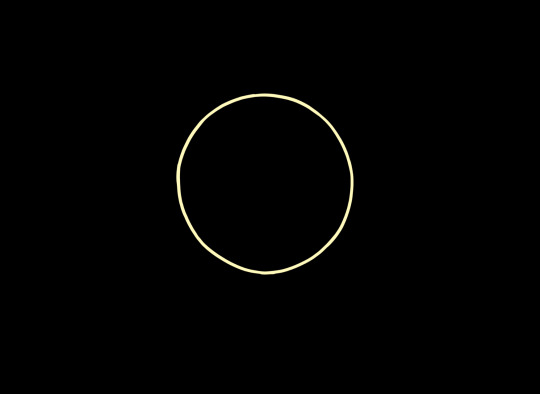
Stunning!!!
#solar eclipse#sun#moon#celestial event#space#stars#funny#humor#humour#lol#joke#satire#dark humor#dark humour#(literally)#hehehe#(also I don’t THINK this is a symbol for anything but if it is lemme know)
34 notes
·
View notes
Text

Moonlight and Venusian Glow: A Conjunction in Pisces
Conjunctions between the Moon and Venus are relatively common, as both objects are bright and easily visible to the naked eye. When they occur in Pisces, it can be a beautiful sight, as Pisces is a constellation located near the ecliptic, which is the path that the Sun, Moon, and planets follow across the sky.
Astrologically, the Moon and Venus carry profound symbolism. The Moon represents emotions, intuition, and the subconscious, while Venus embodies love, beauty, and harmony. Pisces, as a water sign, is associated with creativity, empathy, and spiritual awareness. Astrologers may interpret this conjunction as a period of heightened emotional sensitivity, artistic inspiration, and a time when the boundaries between the conscious and subconscious blur, leading to profound insights and creative breakthroughs.
Moon and Venus in Pisces (January 2025)

Friday , January 3, 2025
#celestial event#astronomy#moon#venus#pisces#constellation#astrology#ai assisted writing#machine art#photography#40x30
12 notes
·
View notes
Text
A Spectacular, Rare Alignment of 6 Planets Is About to Happen in The Sky

An illustration of the June 3 planetary alignment. (Star Walk)
By Michelle Starr
24 May 2024
Six of the planets of the Solar System are about to line up for a rare sight in Earth's sky.
In the wee small hours of 3 and 4 June 2024, Mercury, Mars, Jupiter, Saturn, Neptune, and Uranus will appear in a straight line in an alignment known as a planet parade.
Only Venus will be absent – even Earth's waning crescent moon is going to put in an appearance.
It's not uncommon for several planets to be in the sky at once, but it's less common for more planets to align.
Any number of planets from three to eight constitutes an alignment. Five or six planets assembling is known as a large alignment, but five-planet alignments are significantly more frequent than six.
These alignments do not represent the planets lining up in space like you see in diagrams and illustrations of the Solar System. That's not a thing that actually happens in the real Universe, sadly.
A planetary alignment occurs because the planets of the Solar System all orbit the Sun more or less on a flat plane called the ecliptic.
Some are a little above or below this plane, but it's roughly the same.
This is because of the way stars form, including the Sun.
A baby star in a cloud of material starts spinning; the cloud around them swirls into a disk that feeds into the baby star.
A planet forms from what remains of the disk and, if left to its own devices, will stay in that level position.
This means that, occasionally, the planets will be on the same side of the Sun as they move along their orbits, so we get to see them in the sky at the same time.
They appear to be in a straight line because they're all on the ecliptic.
This is what will be happening in early June, around an hour before sunrise. You might need some visual aids.
While Mercury, Mars, Jupiter, and Saturn will be bright enough to see with the naked eye, Uranus and Neptune are too far and faint.
If you want to catch a glimpse, you'll need binoculars or a telescope.
#parade of planets#planetary alignment#planets#astronomy#astronomical event#celestial event#solar system#Mercury#Mars#Jupiter#Saturn#Neptune#Uranus#crescent moon#Earth#moon#alignment#space#universe#ecliptic#straight line
22 notes
·
View notes
Text

Celestial intervention
It was just what we needed: celestial intervention - a reason to avert our attention from this troubled, chaotic earth and focus on more orderly, more predictable and eminently more satisfying events.
At 4:41 ET this morning, just as we expected, our planet’s natural tilt nudged the Northern Hemisphere to its furthest point away from the sun. Hence, the winter solstice. Not even Congress could screw it up.
You could call it the shortest day of the year. You could call it longest night, or the heart of darkness, or the dregs of daylight. Personally, I’ve always thought of it as the first step in our march back toward the light.
Cheer up! Things are bound to get brighter. For the next six month each day will bring us a little more daylight than the previous day. We can depend on it.
9 notes
·
View notes
Text
youtube
There's a lot to unpack in this one 👆
I have photos of some of the celestial events and lunar eclipses he speaks of. While in the totality of the upcoming solar eclipse, Venus and Jupiter will be close to the sun and very visible and to the West Saturn and Mars will be visible. There will be six planets in Aries, Mercury, Venus, Mars, Jupiter, Chiron and Saturn at the time of the eclipse, which will also happen in Aries. 🤔
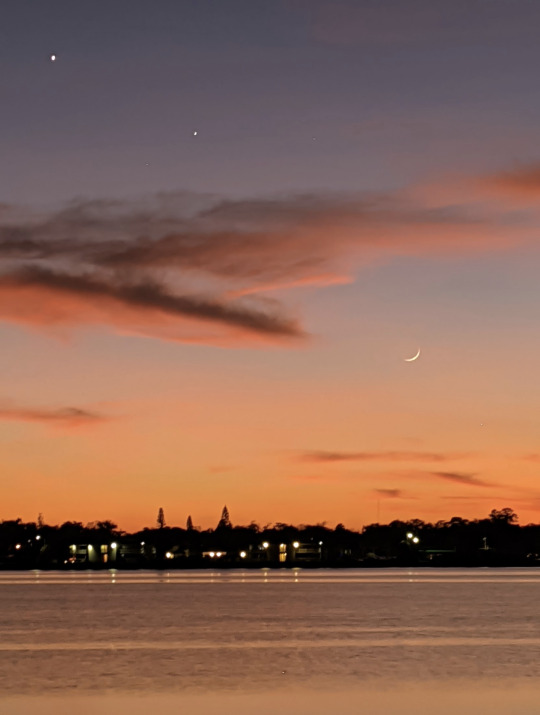
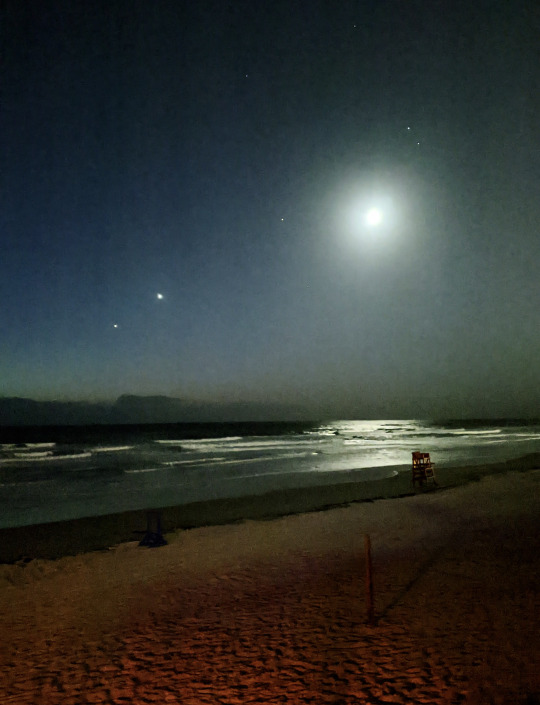
Venus, Jupiter & Moon/Jupiter, Venus, Mars, Saturn & Moon... These 👆 are a couple of planetary alignments I've captured
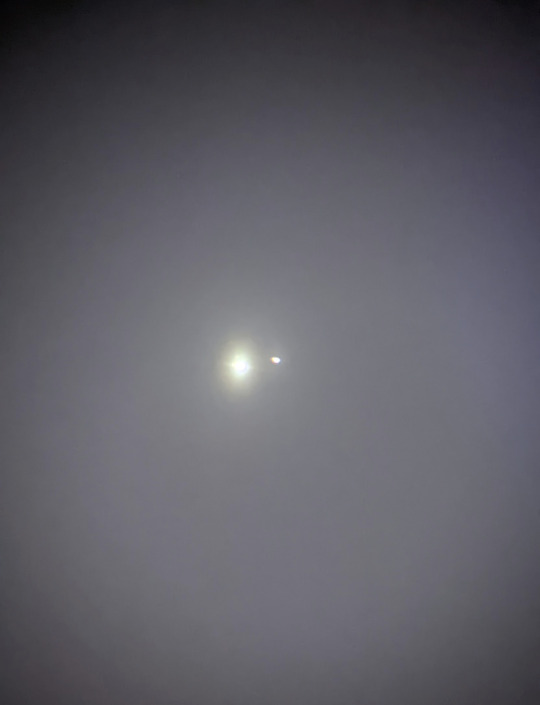
And lets not forget the conjunction of Jupiter and Saturn that happened December 2020.
These events have been occurring since Donald Trump was elected in 2016 and they are still happening. It's a great time to be alive if you're connecting the dots. Coincidence... You Decide 🤔
#pay attention#educate yourselves#educate yourself#knowledge is power#reeducate yourself#reeducate yourselves#think about it#think for yourselves#think for yourself#do your homework#do some research#do your own research#ask yourself questions#question everything#it'sbiblical#bible lesson#scripture#you decide#sun#solar eclipse#celestial event#Youtube
39 notes
·
View notes
Text
ITS ECLIPSE DAY
The total solar eclipse will occur in North America today, April 8, from 1250pm to 320pm CST!
This event will not occur to this magnitude for another 20 years!
Look online to see if you're in the path of totality, stretching from Texas to Maine, but you should go outside and experience it no matter the totality!
Make sure you have protective glasses and if you're using telescopes to also have protective lenses!
#ecplise#total eclipse#astronomy#space is cool#celestial event#eclipse solar#total solar eclipse#outer space#solar system#solar#solar eclipse
14 notes
·
View notes
Text


🌌
#photographers on tumblr#photography#aurora#aurora borealis#northern lights#solar storm#skyscape#sky#space#galaxy#galaxies#space weather#cosmos#celestial#celestial event
14 notes
·
View notes
Text



cosmic_background
In 2025, a rare celestial event called Planet Parade will occur from January 21 to 29, where Venus, Mars, Jupiter, Saturn, Uranus, and Neptune align in the night sky. This alignment offers a unique viewing opportunity for astronomers and stargazers.
I captured the entire “Planetary Parade” using my 11” telescope, and combined everything into one composite photo that stayed true to the angular scale of these objects.
Made entirely with real photos, I hope this composite helps illustrate the scale of these things!
Usually I don’t release work with planets in print because the planets themselves are so small-so this is a rare opportunity to get them in print. You can find the “Planetary Parade” in different crops/sizes up to 5 feet tall at the link in my bio.
In their current order in the sky (actual angle will vary based on latitude and observing time) Starting from the sun: Saturn Venus Neptune Uranus Jupiter Mars
The comet is the G3 Atlas comet there is also a comet visible in the Southern Hemisphere (although it just broke up)
#astronomy#celestial event#planetary alignment#venus#mars#jupiter#saturn#uranus#neptune#moon#cosmos#universe
41 notes
·
View notes
Text

"Everything under the sun is in tune, but the sun is eclipsed by the moon." - Pink Floyd
#Partiality#Sun#Moon#Sun and Moon#Partial Eclipse#Filtered Image#Composite Image#Celestial Event#Our Corner of the Universe#Natural Phenomenon#Moment in Time#photography#photography on tumblr#original photography#photo blog#snapshot
10 notes
·
View notes
Text
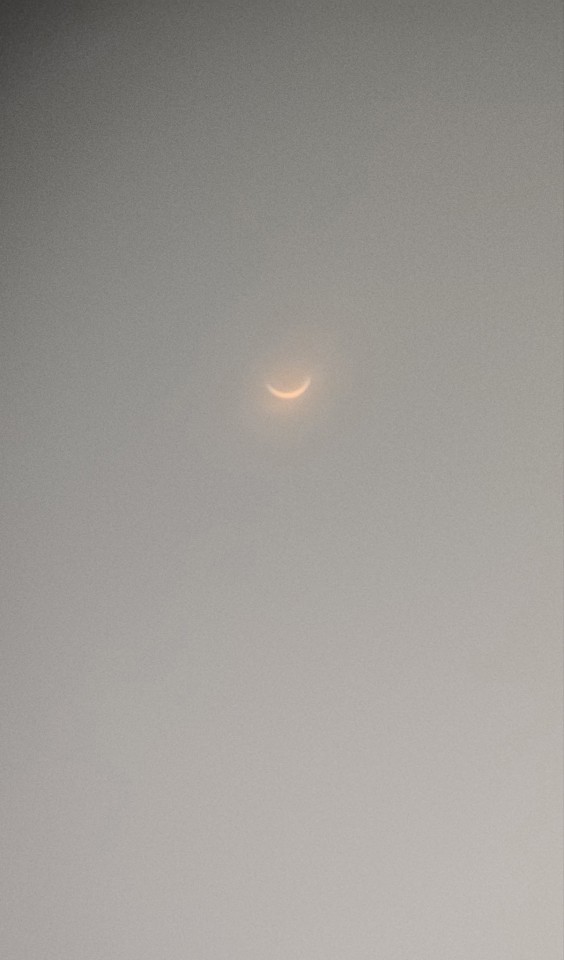
#bugbeast photos#photography#space photography#celestial event#solar eclipse 2024#april 8 eclipse#solar eclipse#i tried#the end#ohio#phone photography#cosmos#space#naturecore#total solar eclipse#path of totality
7 notes
·
View notes
Text
“Who’s watching the eclipse today?”
#simon seville#alvin and the chipmunks#eclipse#watch#alvinnn and the chipmunks#aatc#sun#moon#celestial event#science
5 notes
·
View notes
Text
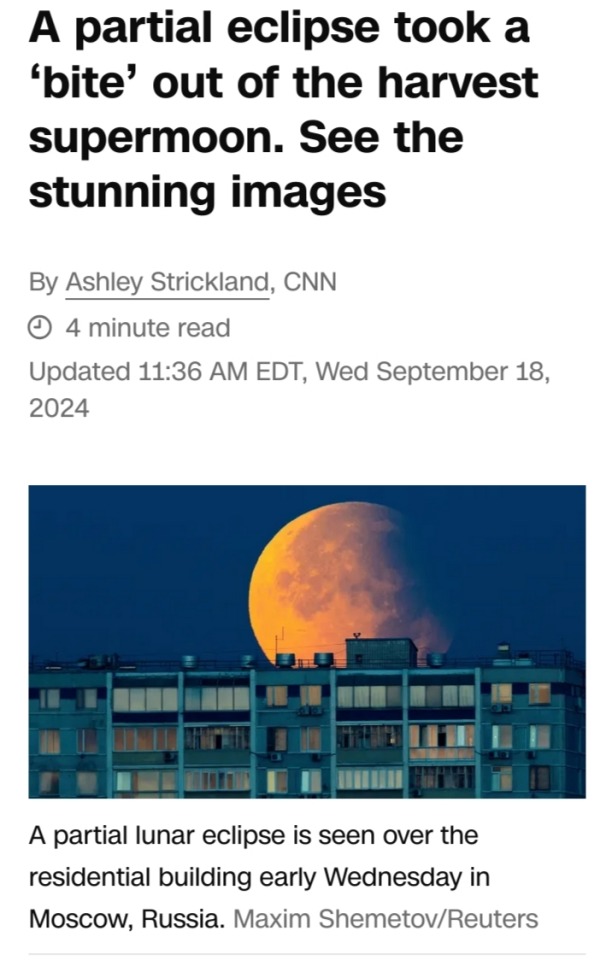
(CNN) — Sky-gazers around the world were able to glimpse a partial lunar eclipse while September’s full harvest moon shone brightly Tuesday night.
The moon peaked at its fullest at 10:35 p.m. ET Tuesday but will appear full through Thursday morning, according to NASA.
If you viewed the moon on Tuesday evening for about an hour, it also appeared as if a bite has been taken out of it due to a partial lunar eclipse.
A partial lunar eclipse occurs when Earth moves between the sun and the full moon without being perfectly aligned.
The celestial event appeared over Europe and much of Asia, Africa, North America, and South America.
The moon entered Earth’s full shadow at 10:13 p.m. ET and exited it at 11:16 p.m. ET.
The peak of the eclipse was expected to occur at 10:44 p.m. ET, according to NASA.
During a total lunar eclipse, Earth’s shadow can turn the moon’s surface a striking red color, which is known as a blood moon, according to NASA.
But that won’t be the case this week, experts say.

“The eclipse (Tuesday) will not be a total lunar eclipse, so the moon won’t appear red, instead a portion of the moon will darken,” said Noah Petro, NASA project scientist for both the Lunar Reconnaissance Orbiter and Artemis III.
“If you didn’t know it were happening or even look at the moon it might not be noticeable.
But the keen observer may notice the ‘top right’ corner of the moon darker than the rest of the moon,” he said via email.
“This is the part that is completely in(Earth’s) shadow, though not a large portion of the moon will be in darkness.
But if its clear out I encourage folks to go out and look, it’s always worthwhile to look at the moon!”

September’s full moon is also considered the second of four consecutive supermoons expected in 2024, according to NASA.
Definitions of a supermoon can vary, but the term generally denotes a full moon that is closer to Earth than normal and thus appears larger and brighter in the night sky.
Some astronomers say the phenomenon occurs when the moon is within 90% of perigee — its closest approach to Earth in orbit.
While the typical distance between Earth and the moon is an average of 238,900 miles (384,472 kilometers), September’s full moon was expected to be just 222,637 miles (358,300 kilometers) away, according to NASA.
And keep an eye out for Saturn, which will look like a bright dot close to the full moon.

Naming The Moon
The name harvest moon is a nod to the season because the event happens close to the beginning of fall, or the autumnal equinox, which occurs on September 22.
Many people associate the harvest moon with being orange in color as it begins to rise, but the same could be said of all full moons.
The hue is due to the greater thickness of Earth’s atmosphere near the horizon, according to EarthSky.
Typically, this time of year is when many summer-planted crops peak in the Northern Hemisphere, and the bright moon once helped farmers work into the evening to harvest their bounty ahead of the first frost, according to The Old Farmer’s Almanac.
Other monikers for September’s full moon — as used across various indigenous tribes — include the “moon of full harvest” from the Hopi people, the “corn maker moon” from the Abenaki tribe, the “moon of the brown leaves” from the Lakota people and “autumn moon” from the Passamaquoddy tribe.
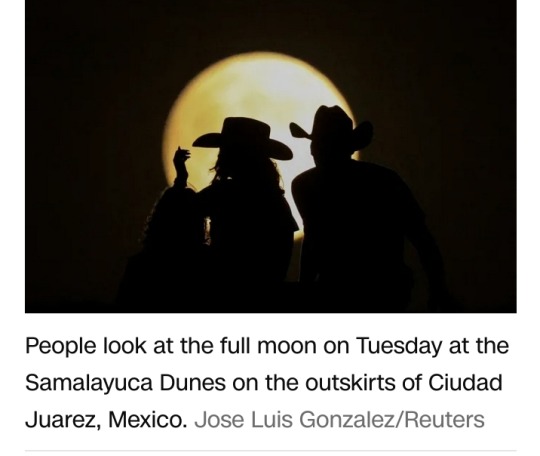
European names for the moon also honor the fall harvest, including the “fruit moon,” a nod to the fruits that ripen as summer ends, and the “barley moon” to mark when the crop is collected from the fields, according to NASA.
Other harvest-celebrating traditions around this time include the Korean festival of Chuseok and the Chinese Mooncake Festival, both of which also celebrate family and the remembrance of ancestors.
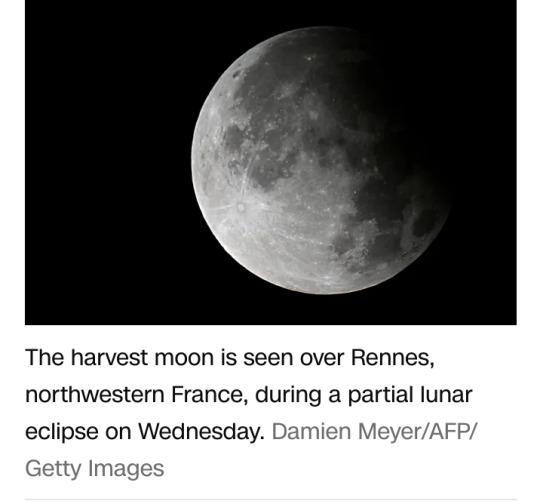
Upcoming Celestial Events
The next full moon, the hunter’s moon occurring on October 17, will also be a supermoon and the closest of the year at 222,095 miles (357,428 kilometers) away.
The beaver moon will occur on November 15, and the final full moon of the year will be the cold moon on December 15.
Meanwhile, sky-gazers can anticipate a busy meteor shower season to close out 2024.
Here are peak dates for upcoming celestial activity, according to the American Meteor Society:
Draconids: October 7-8
Orionids: October 20-21
Southern Taurids: November 4-5
Northern Taurids: November 11-12
Leonids: November 17-18
Geminids: December 13-14
Ursids: December 21-22
#partial lunar eclipse#full harvest moon#earth#sun#full moon#moon#celestial event#NASA#total lunar eclipse#blood moon#Lunar Reconnaissance Orbiter#Artemis III#supermoon#perigee#harvest moon#autumnal equinox#fall#Northern Hemisphere#fruit moon#barley moon#Chuseok#Mooncake Festival#hunter’s moon#beaver moon
4 notes
·
View notes
Text

4 notes
·
View notes